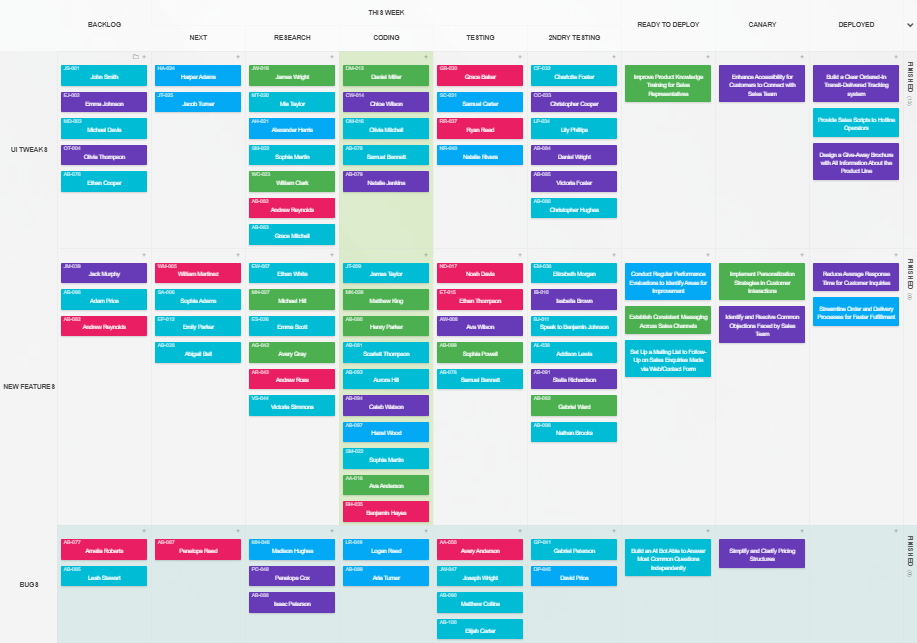Blog
From Assembly Lines to Agile Teams — The Timeless Appeal of Kanban02 Jan 2025
Kanban’s evolution from a manufacturing method to a widely adopted project management technique is a testament to its adaptability and enduring relevance, due in large part to its simplicity. Originally used to optimize workflows and minimize waste on the Toyota manufacturing floor in the 1950s, Kanban has since expanded into industries ranging from software development to marketing and healthcare. This transformation highlights how fundamental principles of efficiency and visualization can transcend contexts, offering solutions for the complexities of modern knowledge-based work.
The roots of Kanban
The application of Kanban for work managment begins in post-World War II Japan, at Toyota. During this period, the automaker's engineers sought ways to enhance efficiency and align production with demand. Inspired by the inventory management systems of supermarkets, they developed a system that used visual cues—cards, known as "Kanban"—to signal the need for inventory restocking. The practice formed the backbone of Toyota’s just-in-time (JIT) production system.

By linking each step of the production process with visual signals, the Kanban system minimized excess inventory and ensured that resources were used only when necessary. It allowed Toyota to achieve remarkable levels of efficiency, reducing waste while maintaining high production quality. The success of the Kanban system in auto manufacturing laid the groundwork for its later adaptations in other industries.
The transition to knowledge work
In the late 20th century, as many industries shifted toward knowledge-based work, Kanban’s potential for managing workflows outside of factories began to emerge. Software development, in particular, saw an increasing need for tools that could provide transparency and adaptability. The rise of Agile methodologies during the 1990s and 2000s further highlighted this need, as teams sought frameworks to visualize work, manage tasks, and prioritize effectively in dynamic environments.
The application of Kanban to knowledge work is rooted in its core principles:
- Visualizing work: Mapping tasks onto a visual board divided into stages (e.g., "Backlog", "Doing", "Done") provides clarity for both the team and stakeholders.
- Limiting work-in-progress (WIP): Constraining the number of tasks that can be worked on simultaneously ensures focus and prevents overburdening team members.
- Managing flow: Continuous monitoring of tasks as they move through the stages helps identify bottlenecks and optimize processes.
- Continuous improvement: Regularly evaluating the workflow lets teams refine their processes and incrementally enhance efficiency.
Kanban in modern project management

Today, Kanban is a cornerstone of project management across countless industries. Its adaptability and simplicity make it an invaluable tool for managing large, multifaceted projects. Its relevance is underscored by the following features:
Clarity and transparency
Kanban boards offer a shared understanding of project status at a glance. Teams can see exactly what tasks are pending, in progress, or completed, which fosters alignment and reduces the need for exhaustive status updates. Digital Kanban boards, integrated with additional project management features, further enhance this visibility through aspects such as color-coded tags, automated status updates or seamless time tracking.
WIP limits
One of Kanban’s defining characteristics is its emphasis on restricting the number of tasks in progress. By capping WIP, teams can avoid the pitfalls of multitasking and ensure that started tasks receive the necessary attention. The single-task focus enhances productivity and reduces the risk of burnout, especially in high-stress environments.
Incremental delivery
The Kanban technique enables teams to deliver work incrementally, which is particularly valuable in environments where priorities frequently shift. Teams can quickly adapt to new requirements or changes in scope without overhauling their entire workflow. That is what made Kanban a natural fit for Agile and Lean practices.
Continuous improvement
Regular retrospectives and analysis of workflow data allow teams to identify inefficiencies and implement changes iteratively. Digital Kanban tools often include metrics like cycle time and lead time, providing actionable insights to drive improvements.

Reaching beyond software development
While Kanban’s adoption in software development is well-documented, its utility extends far beyond that domain, for example:
- Marketing: Teams use Kanban to manage campaigns, content production, and social media strategies. The visual representation of workflows helps prioritize tasks and meet tight deadlines. View a Kanban Tool use case in marketing.
- Healthcare: Hospitals and clinics use Kanban to streamline patient care processes, manage supplies, and coordinate between departments. View a Kanban Tool use case in healthcare.
- Manufacturing and logistics: Even in its original domain, Kanban continues to evolve with digital tools that integrate supply chain data and predictive analytics. View a Kanban Tool use case in production.
- IT: IT teams rely on Kanban to coordinate software release and maintenance schedules, manage on-site hardware, and track progress against timelines. View a Kanban Tool use case in IT.
Digital Kanban - the present of workflow management
The advent of digital Kanban tools in the early 2000s has further expanded its capabilities. Online platforms provide real-time collaboration for distributed teams, ensuring that everyone remains aligned regardless of location. Advanced features such as automation, analytics, and integrations with other software have made Kanban an indispensable resource in the modern workplace. If you're curious to see a few examples of digital Kanban for modern task management, please view this video collection.
Kanban's evolution from its origins on Japanese factory floors to its widespread adoption in global project management offices showcases its versatility and efficiency. Its evolution reflects not only the changing nature of work but also the timeless need for intuitive systems that enhance productivity, simplify and encourage collaboration. As industries continue to adapt to new challenges, Kanban’s principles will undoubtedly remain at the forefront of efficient project management.

Sign up for a 14-day free trial
to test all the features.
Sign up now and see how we can help
your organization deliver exceptional results.